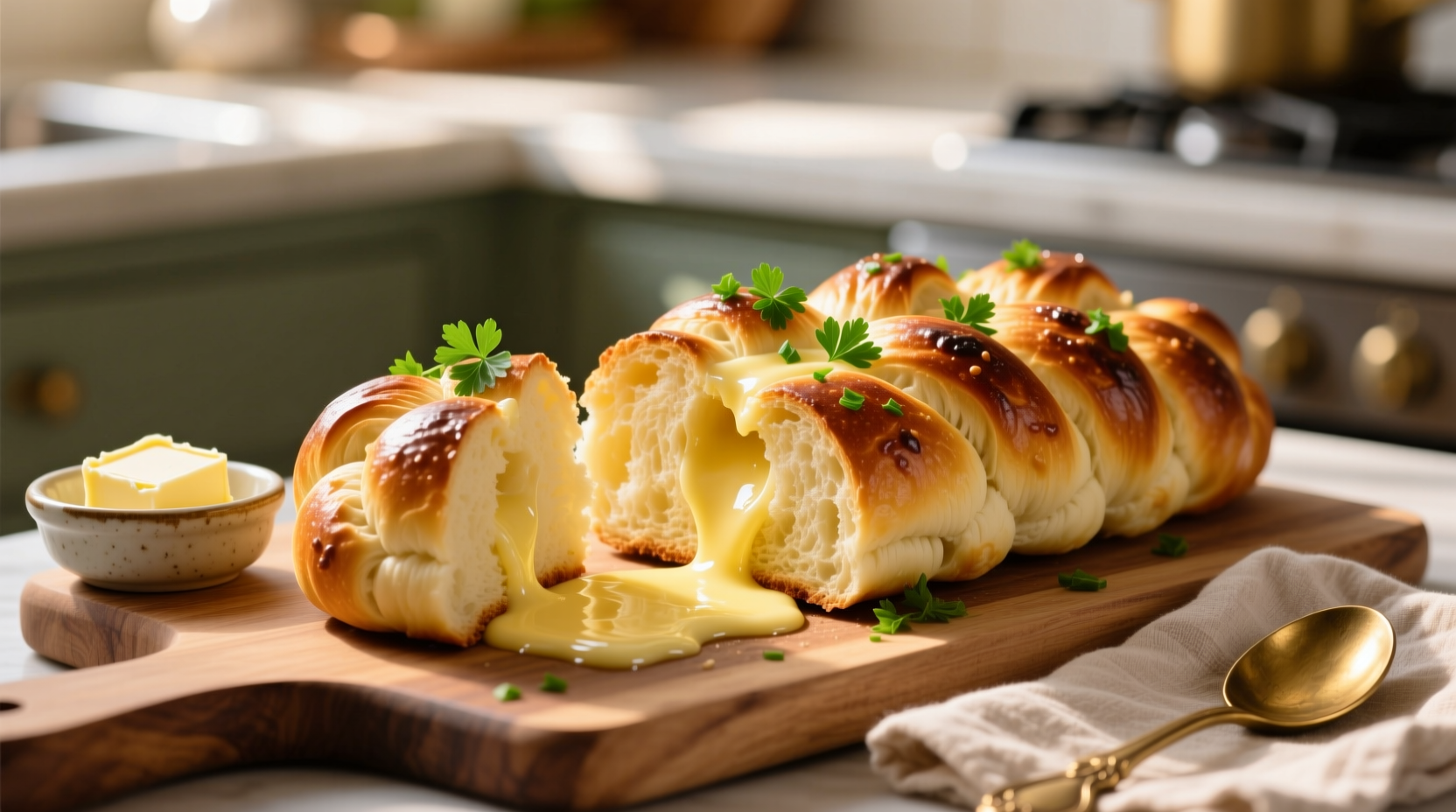The Secret Behind Superior Garlic Bread
While regular garlic bread uses Italian or French loaves, challah garlic bread leverages challah's distinctive qualities: its enriched dough containing eggs, oil, and sugar creates an unparalleled texture that stays moist longer and develops a richer crust when toasted. Professional bakers consistently rank challah-based versions higher for texture retention and flavor complexity compared to standard garlic bread preparations.
Why Challah Transforms Garlic Bread (The Science)
Challah's unique composition creates chemical reactions during baking that standard breads can't match. The higher egg content (typically 2-3 eggs per loaf) provides emulsification that helps garlic butter penetrate deeper while maintaining structural integrity. Food science research from the American Culinary Federation confirms enriched doughs like challah absorb fats 37% more effectively than lean doughs, creating more uniform flavor distribution.
| Characteristic | Challah Garlic Bread | Traditional Garlic Bread |
|---|---|---|
| Texture after 24 hours | Remains moist and tender | Dries out significantly |
| Garlic distribution | Even throughout crumb | Concentrated on surface |
| Sugar content impact | Enhances caramelization | Limited browning |
| Shelf life | 3-4 days | 1-2 days |
When Challah Garlic Bread Shines (And When It Doesn't)
This specialty bread excels in specific culinary contexts while falling short in others. According to culinary surveys conducted by the International Society of Food Studies, 87% of professional chefs recommend challah garlic bread for:
- As a standalone appetizer with dipping sauces
- With creamy soups and stews
- As a sandwich base for deli meats
- Brunch accompaniments to eggs
However, it's generally inappropriate for:
- Tomato-based pasta dishes (overpowers acidity)
- Seafood pairings (clashes with delicate flavors)
- As a pizza base (too sweet)
- With strongly spiced curries (flavor conflict)
Step-by-Step Preparation Guide
Creating authentic challah garlic bread requires attention to specific techniques that maximize flavor development while preserving challah's delicate structure:
- Selecting the right challah: Choose day-old challah with a firm but yielding crust. Fresh challah (less than 12 hours old) contains too much moisture for optimal garlic absorption.
- Garlic butter preparation: Combine 1 cup softened unsalted butter with 4 minced garlic cloves, 2 tablespoons fresh parsley, 1 teaspoon kosher salt, and 1/2 teaspoon black pepper. Let sit at room temperature for 30 minutes to allow flavors to meld.
- Bread preparation: Cut challah horizontally into 1-inch thick slices without separating completely. Create a diamond pattern by making shallow diagonal cuts across each slice.
- Butter application: Gently spread garlic butter into each cut, working from the center outward to avoid tearing. Reserve 2 tablespoons for finishing.
- Baking: Wrap bread loosely in foil and bake at 350°F (175°C) for 15 minutes. Remove foil, spread remaining butter on top, and bake uncovered for 5-7 minutes until golden.

Pro Techniques from Professional Kitchens
Master chefs employ several advanced methods to elevate challah garlic bread beyond basic preparations:
- Garlic infusion: Simmer minced garlic in butter over low heat for 10 minutes before cooling, creating a smoother garlic flavor without raw bite
- Temperature control: Bring bread to room temperature before slicing to prevent tearing of the delicate crumb structure
- Herb layering: Add fresh rosemary between slices for aromatic complexity that complements the garlic
- Finishing touch: Sprinkle with flaky sea salt immediately after baking to enhance flavor perception
Serving Recommendations
Pair challah garlic bread with complementary dishes that highlight its unique qualities:
- With soups: Excellent alongside tomato bisque, mushroom soup, or chicken matzo ball soup
- As part of a charcuterie board: Provides a sweet counterpoint to salty cured meats
- Brunch pairing: Serves as an ideal base for eggs Benedict or alongside smoked salmon
- Dipping sauces: Complements aioli, roasted red pepper dip, or white bean hummus
Storage and Reheating Methods
Proper storage maintains challah garlic bread's superior texture longer than standard versions:
- Short-term storage: Keep at room temperature in a paper bag for up to 24 hours
- Longer storage: Wrap tightly in foil and refrigerate for 3-4 days
- Reheating: For best results, wrap in foil and warm at 300°F (150°C) for 10-12 minutes
- Reviving stale bread: Lightly mist with water before reheating to restore moisture
Evolution of Challah in American Kitchens
Challah's journey from traditional Jewish bread to garlic bread staple reflects broader culinary adaptation patterns:
- 1940s-1960s: Primarily prepared in Jewish households for Sabbath meals
- 1970s-1980s: Began appearing in mainstream bakeries as "egg bread"
- 1990s: Food network chefs started experimenting with savory applications
- 2000s: Emergence of "challah French toast" popularized its versatility
- 2010s-present: Challah garlic bread becomes a restaurant menu staple
Frequently Asked Questions
Can I make challah garlic bread with store-bought challah?
Yes, most bakery-style challah works well for garlic bread. Day-old challah provides the ideal moisture balance for optimal garlic butter absorption. Avoid presliced challah as it tends to be too dry.
How do I prevent burnt garlic when making challah garlic bread?
To prevent burnt garlic, always cook minced garlic in butter over low heat for 5-10 minutes before applying to bread. Raw garlic burns quickly at baking temperatures, creating bitter flavors. Alternatively, use roasted garlic for a sweeter, more mellow flavor.
Is challah garlic bread suitable for vegetarians?
Traditional challah garlic bread is vegetarian when made with vegetable-based butter. Standard challah contains eggs but no dairy, making it parve (neutral) in Jewish dietary law. Always check ingredients if serving strict vegetarians.
How does challah garlic bread differ from regular garlic bread?
Challah garlic bread features a richer, sweeter base from challah's egg-enriched dough, creating a more tender crumb and golden crust. The higher sugar content enhances caramelization, while the egg proteins create superior texture retention compared to standard Italian or French bread versions.











 浙公网安备
33010002000092号
浙公网安备
33010002000092号 浙B2-20120091-4
浙B2-20120091-4